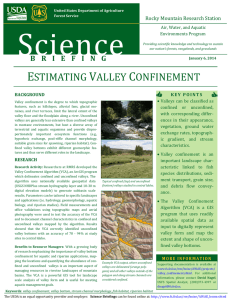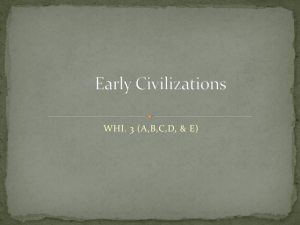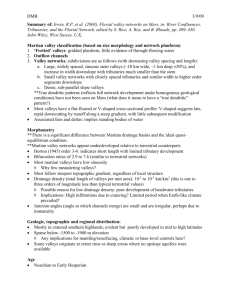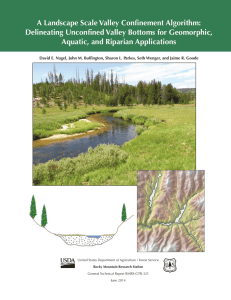A Valley Confinement Algorithm for Aquatic, Riparian, and Geomorphic Applications
advertisement
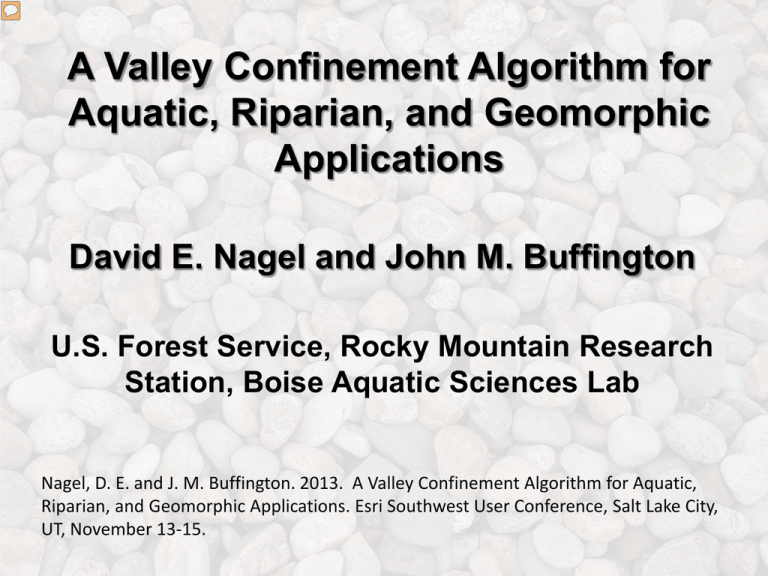
A Valley Confinement Algorithm for Aquatic, Riparian, and Geomorphic Applications David E. Nagel and John M. Buffington U.S. Forest Service, Rocky Mountain Research Station, Boise Aquatic Sciences Lab Nagel, D. E. and J. M. Buffington. 2013. A Valley Confinement Algorithm for Aquatic, Riparian, and Geomorphic Applications. Esri Southwest User Conference, Salt Lake City, UT, November 13-15. Boise Aquatic Sciences Lab Idaho Water Center Fish and watershed research Valley Confinement Algorithm (VCA) Python Script Objective: Identify unconfined valleys at a landscape scale using nationally available GIS data Valley Characteristics and Justification Valley Confinement Degree of lateral confinement of a valley, constrained by topographic features Confined Confining features Unconfined Confining features Confined Bankfull width Confinement ratio 15/10 = 1.5 10 m 15 m Unconfined Confinement ratio 40/10 = 4 Bankfull width 10 m 40 m Confined Shallow alluvial deposits Unconfined Deeper alluvial deposits Confined Unconfined Characteristics of Unconfined Valleys • • • • Hyporheic exchange Channel morphology Grain size Riparian habitat Hyporheic Exchange Baxter and Hauer 2000 Bull trout preferentially spawn at the downstream end of unconfined valleys where hyporheic upwelling may warm stream temperatures for overwintering embryos Boulton and others 2010 Channel morphology Cascade Step-pool Plane-bed Pool-riffle Montgomery and Buffington 1997 Channel morphology Confined Unconfined Pool-riffle morphology has 80% more pool area and 40% deeper pools, favored by juvenile salmon McDowell 2001; Hall and others 2007 Grain Size Spawning Chinook salmon prefer grain sizes that are often associated with unconfined valleys Isaak and Thurow 2006 Riparian Areas Riparian areas, often associated with unconfined valleys, provide disproportionately important ecosystem functions compared to confined valleys Wissmar 2004 VCA Valley Confinement Algorithm Python script with an interface that allows users to vary the results based on the needs of the application VCA Inputs Uses nationally available NHDPlus data DEM Flow lines Average annual precipitation Water bodies Algorithm Sequence Valley flood Slope cost distance Ground slope Initial valley bottom extent Filtering Valley bottom polygons Valley Flood Objective: Flood the valley floor as a factor of bankfull depth If bankfull depth is 0.5 m, a flood factor of 3 will flood the valley to 1.5 m above the channel. Flood depth Bankfull depth Computing Bankfull Depth For channels in the Columbia River basin hbf = 0.054A0.170P0.215 hbf is bankfull depth (m) A is contributing area (km2) P is average annual precipitation (cm) Hall and others 2007 Computing Bankfull Depth 0.054A0.170P0.215 = hbf BANKFD * Flood factor = Flood depth (3) + = Elevation Flooded elevation Flooded Elevation Flooded elevation Ground elevation Initial Valley Bottom Intersection of flooded elevation with ground elevation Valley bottom extent 10 km Clean Up Nonchanneled valleys Confined valleys Slope Cost Distance Restricts processing to near stream locations X Distance from streams = Slope Slope cost distance threshold Eliminates non-channeled valleys Slope cost Ground Slope Threshold Slope < 9% slope Helps eliminate confined valleys Quad Map and DEM Comparison 40’ (12 m) contours 2 m contours DEMs may have higher ground slope than indicated by quad maps Results 10 km Filtering Stream Length and Polygon Size Criteria X X X X X X XX X 10 km Validation and Results Field Validation 78% of field sites identified as unconfined by the VCA had a confinement ratio greater than 4. Office Validation Quad Maps and Aerial Photography South Fork Boise River Basin Accuracy = 94% South Fork Salmon River Basin Accuracy = 87% Landscape Scale Results 10 km THANK YOU Dave Nagel dnagel [at] fs.fed.us Acknowledgements: Sharon Parkes, Seth Wenger, and Jaime Goode References Baxter, C.V. and F. R. Hauer. 2000. Geomorphology, hyporheic exchange, and selection of spawning habitat by bull trout (Salvelinus confluentus). Canadian Journal of Fisheries and Aquatic Science 57(7):1470-1481. Boulton, A.J., T. Datry, T. Ksaahara, M. Mutz, and J.A. Stanford. 2010. Ecology and management of the hyporheic zone: streagroundwater interactions of running waters and their floodplains. Journal of the North American Benthological Society, 29(1):2640. Boxall, G. D., G. R. Giannico, and H. W. Li. 2008. Landscape topography and the distribution of Lahontan cutthroat trout (Oncorhynchus clarki henshawi) in a high desert stream. Environmental Biology of Fishes 82:71-84. Hall, J. E., D. M. Holzer, and T. J. Beechie. 2007. Predicting River Floodplain and Lateral Channel Migration for Salmon Habitat Conservation. Journal of the American Water Resources Association 43:786–797. Isaak, D.J., and R.F. Thurow. 2006. Network-scale spatial and temporal variation in Chinook salmon (Oncorhynchus tshawytscha) redd distributions: patterns inferred from spatially continuous replicate surveys. Canadian Journal of Fisheries and Aquatic Sciences 63:285-296. McDowell, P. F. 2001. Spatial variations in channel morphology at segment and reach scales, Middle Fork John Day River, northeastern Oregon. In: Dorava, D. M., D. R. Montgomery, B. B. Palcsak and F. A. Fitzpatrick, Geomorphic Processes and Riverine Habitat, Water Science and Applications, Volume 4, American Geophysical Union, Washington DC, 159-172. Montgomery, D. R. and J. M. Buffington. 1997. Channel-reach morphology in mountain drainage basins. Geological Society of America Bulletin 109:596-611. Wissmar, R.C. 2004. Riparian corridors of Eastern Oregon and Washington: Functions and sustainability along lowland-arid to mountain gradients. Aquatic Sciences 66:373-387.
